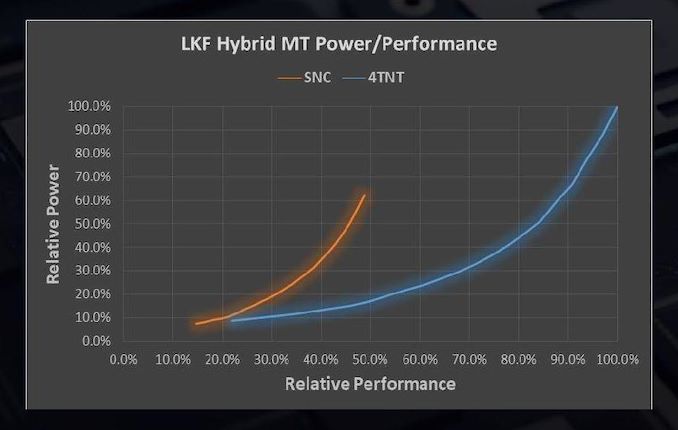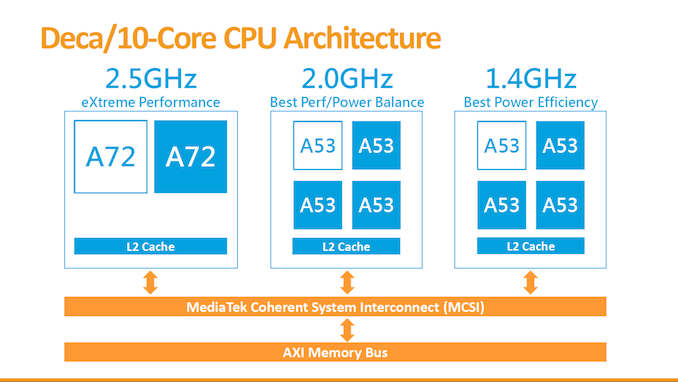The Intel Lakefield Deep Dive: Everything To Know About the First x86 Hybrid CPU
by Dr. Ian Cutress on July 2, 2020 9:00 AM ESTHow To Treat a 1+4 Hybrid CPU
At the top of the article, I explained that the reason for using two different types of processor core, one big on performance and the other big on efficiency, was that users could get the best of both worlds depending on if a workload could be run efficiently in the background, or needed the high performance for a user experience interaction. You may have caught onto the fact that I also stated that because Intel is using a 1+4 design, it actually makes more sense for multi-threaded workloads to run on the four Atom cores.
Using a similar power/performance graphs, the effect of having a 1+4 design is quite substantial. On the left is the single core power/performance graphs, but on the right is when we compare 1 Sunny Cove to all 4 Tremont cores working together.
Where the previous graph considered a 1+1 design, which is more relevant in those user experience scenarios listed above, on the right is the 1+4 design for when the user demands a heavier workload that might not be latency critical. Because there are four Atom cores, the blue line multiplies by four in both directions.
Now obviously the real world scenario is somewhere between the two, as it is possible to use only one, two, or three of the smaller cores at any given time. The CPU and the OS is expected to know this, so it can govern when workloads that can be split across multiple cores end up on either the big core or the small core.
In this graph from Intel, we have three distinct modes on which threads can operate.
- ‘Sunny Cove/SNC’ is for responsiveness and user experience threads,
- ‘Tremont/TNT Foreground’, for user related tasks that require multiple threads that the user is waiting on.
- ‘Tremont/TNT Background’, for non-user related tasks run in efficiency mode
Even though the example here is web browsing, it might be best to consider something a bit beefier, like video encoding.
If we run video encoding, because it is a user related task that requires multiple threads, it will run on the four Tremont cores (TNT FG). Anything that Windows wants to do alongside that gets scheduled as TNT BG. If we then open up the start menu, because that is a responsiveness task, that gets scheduled on the SNC core.
Is 1+4 the Correct Configuration?
Intel here has implemented a 1+4 core design, however in the smartphone space, things are seen a little differently. The most popular configuration, by far, is a 4+4 design, simply because a lot of smartphone code is written to take advantage of multiple foreground or multiple background threads. There are a number of cost-down designs that reduce die area and power by going for a 2+4 implementation. Everyone seems adamant that 4 is a good number for the smaller cores, partly because they are small and cheap to add, but because Arm’s quad-core implementation is a base unit for its IP.
The smartphone space in recent quarters has also evolved from a two tier system of cores. In some of the more leading edge designs, we now have three types of core: a big, a middle, and a small. Because of the tendency to stay with eight core designs, we now get 1+3+4 or 2+2+4 designs, powered by complex schedulers that manage where to put the threads for the best user experience, the best battery life, or somewhere in the middle. Mediatek has been famously dabbling in 10 core designs, going for a 2+4+4 approach.
One thing missing from all of these implementations is an SoC with one big core and four small cores. Smartphone vendors don’t seem to be interested in 1+4 silicon, and yet Intel has decided on it for Lakefield. This is borne out of decisions made on both sides.
From the smartphone perspective, when hybrid designs came about, the big cores just weren’t powerful enough on their own. In order to offer something more than simply basic, at least two cores were needed, but because of how Arm architected the big and little designs, it almost became standard to look into 4+4 implementations of big and small cores. It was only until this configuration was popularized over a couple of years, and Arm big cores got more powerful, that chip designs started looking at 2+4, or 1+3+4 designs.
On Intel’s side of the fence, the biggest problem it has is the size of the Sunny Cove core. By comparison, it’s really, really big. Because the graphics core is the same as Ice Lake and reuses its design, there simply isn’t enough room within the 82 mm2 compute die to add another core. Not only that, but there is a question of power. Sunny Cove wasn’t built for sub-1W operation, even in the Tremont design. We see big smartphone silicon pulling 4-5W when all eight cores are active – there is no way, based on our understanding of Intel’s designs, that we could see four (or even two) Sunny Cove cores being in the optimal performance per watt range while being that low. Intel’s Lakefield graphics, with 64 EUs, is running at only 500 MHz – a lot lower than the Ice Lake designs. Even if Intel moved that down to a 32 EU design to make space for another Sunny Cove core, I reckon that it would eat the power budget for breakfast and then some.
Intel has made the 1+4 design to act as a 0+4 design that sometimes has access to a higher performance mode. Whereas smartphone chips are designed for all eight cores to power on for sustained periods, Lakefield is built only for 0+4 sustained workloads. And that might ultimately be its downfall. This leads onto a deep discussion about Lakefield’s performance, and what we should expect from it.














221 Comments
View All Comments
yeeeeman - Friday, July 3, 2020 - link
The successor (Gracemont) comes next year in Alder Lake S. Stop being a hater and go eat your amd cake.anonomouse - Thursday, July 2, 2020 - link
There are bigger challenges for asymmetric core design beyond just the actual ISA support and scheduling, too. Multithreaded software has lots of assumptions around locks and spinlocks in particular that will have to be tuned, and effective priority inversions will be problematic too. Like where a thread on the big core has to wait on a lock that is held by a thread running on a small core.Notebookcheck's article made it seem like the scheduling right now just doesn't sustain using all of the Tremonts + the Sunny Cove at the same time, which neatly sort of sidesteps the issue for now, at obvious cost of the perf of that bigger core. Not clear whether that's intended behavior that will stick around.
wr3zzz - Thursday, July 2, 2020 - link
There is no need for so many little cores if software were not designed to continuously phone home with our personal data, or skimming money continuously via micro-transactions. The entire ecosystem of phones is designed around that concept. PC, not so much, for now.jeremyshaw - Thursday, July 2, 2020 - link
Too late. MSFT and Intel are pushing that rehashed garbage "Modern Standby" (formerly Connected Standby, InstantGo, etc), which is trying to make laptops that don't go into standby - rather they go into a low idle state and "perform tasks" throughout the night.Usually, it just drains the battery on my laptop (I have long disabled automatic mail retrieval, and any other scheduled task) and forces the laptop into hibernate. Just what I want out of my laptop - less battery life.
Luckily for us, AMD laptops don't support this garbage fire.
MSFT... just because Apple was able to successfully implement "Modern Standby" almost a decade ago, doesn't mean you can. Wake up. Or not.
abufrejoval - Friday, July 3, 2020 - link
Yeah, had to laptop batteries killed because they woke up in the middle of a flight packed tight and overheating. Hybrid and modern standby are absolute "killer features".brantron - Thursday, July 2, 2020 - link
Why not two tiny Cannon Lake cores?I'm no Intel engineer, but the inconvenient fact remains that such a device would be more useful to the average person.
That leaves Lakefield with the appearance of a frankenstein experiment. Sorry Intel, sounds fun, but I don't buy those for $1,000+.
serendip - Thursday, July 2, 2020 - link
This is the most damning quote from the article:"Intel has made the 1+4 design to act as a 0+4 design that sometimes has access to a higher performance mode. Whereas smartphone chips are designed for all eight cores to power on for sustained periods, Lakefield is built only for 0+4 sustained workloads. And that might ultimately be its downfall."
And this is going into $1000 devices like the Galaxy Book S and Thinkpad Fold. The ARM 8cx variant of the Galaxy Book S is $999, the Surface Pro X with an upgraded 8cx is also $999, and these offer i5 level performance when running ARM code. They also have surprisingly beefy integrated GPUs.
Now imagine paying $999 for a 4-core Atom device with a Sunny Cove core that mostly sits idle. I've used cheap Bay Trail and Apollo Lake Atoms, they're decent performers at low price points but they don't belong in anything over $500 because they're still laggy.
I've also compared the Pentium 4415Y vs. the m3-8100Y in the old and new Surface Go: the Kaby Lake Pentium dual-core feels slightly laggy because it can't turbo, whereas the m3 feels much more snappy when it turbos. Even then, the Pentium still feels more snappy than Apollo Lake because single-core performance is higher. For daily use, Windows likes fat beefy cores with high turbo because a lot of the UI is single-threaded.
brantron - Friday, July 3, 2020 - link
And in addition to the m3's turbo, there's hyper-threading and AVX to account for.What clock speed would Ice Lake Y or Tiger Lake Y have with no hyper-threading or AVX?
Something doesn't add up here, and it's not just the bizarre hybrid cores.
serendip - Friday, July 3, 2020 - link
Yes, the m3 has HT and so does the much maligned Pentium Gold 4415Y and 4425Y.Lakefield looks fascinating from purely technical viewpoint but from a value standpoint, it looks to be a disaster. Intel actually thinks 4 Tremont Atom cores are going to be the main cores for $1000 devices.
Meteor2 - Friday, July 3, 2020 - link
Think of the margins though